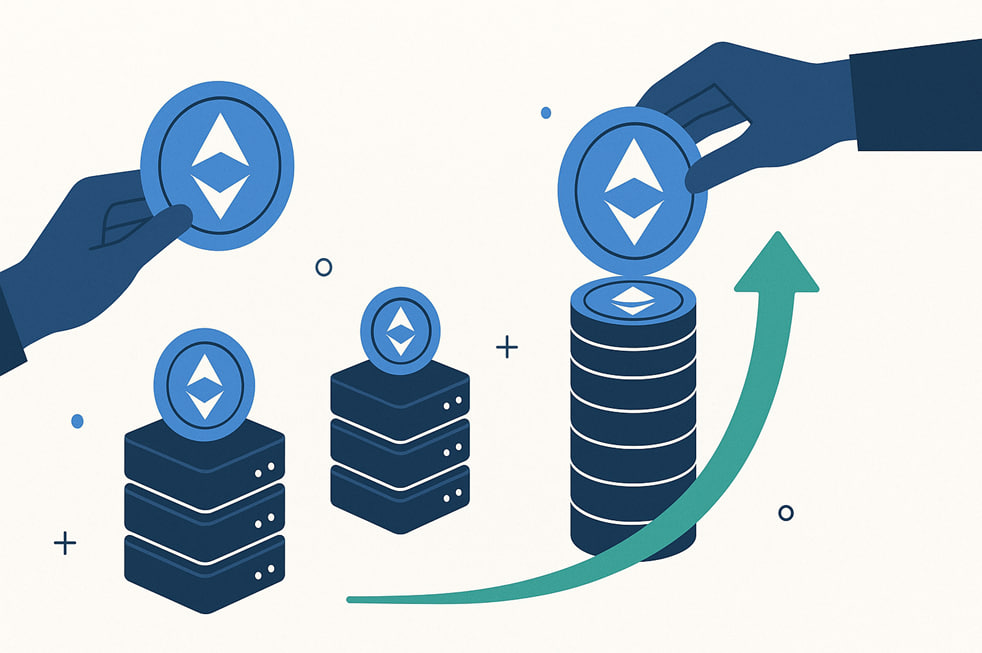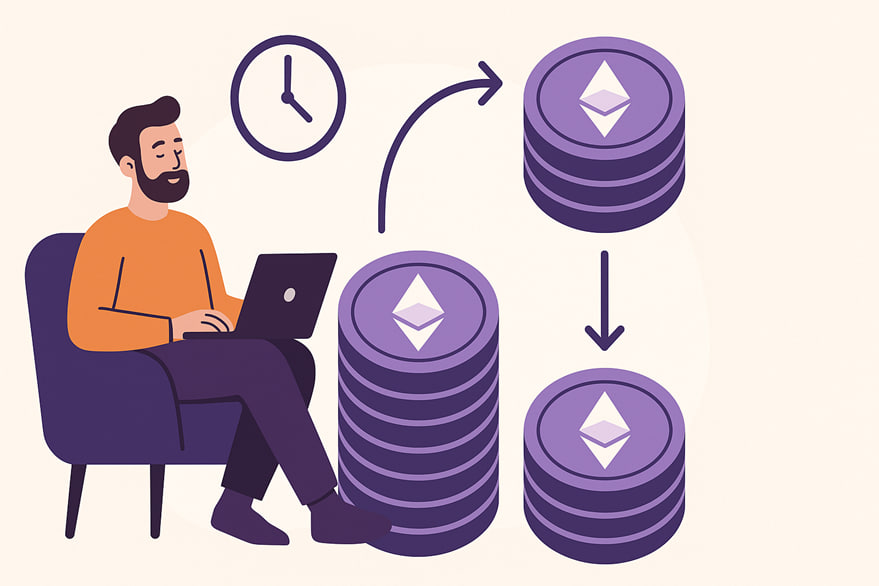What Is Restaking? How It Works and How to Profit from It

Contents
- Introduction
- What Is Restaking
- How Restaking Works
- Examples of Restaking Platforms
- Benefits of Restaking
- Risks and Drawbacks of Restaking
- Restaking: How to Start and What to Consider
- Conclusion
Introduction
Restaking is a tool in the DeFi ecosystem that allows users to increase the yield of already staked tokens. Instead of contributing to a single network’s security, tokens can be reused, for example, within additional protocols or services. This approach has become widespread and popular among users looking to make the most efficient use of their assets.
What Is Restaking

Definition of Restaking
Restaking is a mechanism that allows already staked tokens to be reused in other protocols without being withdrawn from the primary staking. Rather than remaining idle, these assets continue to work, generating additional income.
Simply put, you have staked your tokens, and now those same tokens are used elsewhere, for example, to help secure other projects. This enables you to earn multiple income streams from a single asset.
Difference from Classic Staking
Classic staking involves participating in a single network where tokens are locked and earn a fixed or predictable return.
Restaking is the next level: tokens continue operating in the leading network but are also used in other protocols, usually to help secure them.
Multistaking is a broader approach where the same asset can simultaneously participate in multiple yield mechanisms, not necessarily limited to validation, as in restaking. This can include involvement in DeFi protocols, DAOs, or farming via derivatives.
Parameter | Classic Staking | Restaking | Multistaking |
Income source | Single | Multiple | Multiple |
Token utilization | Single network | Multiple protocols | Various mechanisms and scenarios |
Flexibility | Low | Medium/High | High |
Risk | Moderate | Elevated (protocol risk) | Scenario-dependent (higher than average) |
Technical complexity | Low | Medium | Medium to High |
Restaking and multistaking are suitable for those seeking to maximize the efficiency of their assets. However, it’s essential to understand how and where your tokens are being used—additional income sources often come with increased risks and more complex management logic.
How Restaking Works

Restaking is based on the use of smart contracts. The process relies on special tokens you receive in exchange for participating in staking—these are so-called liquid staking tokens (LSTs), such as stETH.
First, you stake your tokens—locking them in the network. You then receive a liquid version of these tokens. You can transfer this version to other platforms that allow asset reuse. There, the tokens continue to “work” and generate additional yield. Meanwhile, the original stake remains locked, and rewards are earned.
This means a single asset provides two income sources. All of this works automatically—smart contracts manage the tokens and prevent you from taking on more risk than you can handle.
Smart Contracts
Smart contracts play a key role in the mechanics of restaking. They ensure the proper functioning of the system and enforce the following conditions:
-
Usage uniqueness control – prevent simultaneous involvement of tokens in incompatible protocols (e.g., double staking usage);
-
Correct income calculation – track how much and where rewards should be distributed.
-
Access management – allow token withdrawal only under defined rules (e.g., after the lock-up period or according to protocol exit conditions).
Simply put, smart contracts serve as automated coordinators and protectors: they enforce the rules, minimize human error, and make reusing tokens safer and more predictable.
Examples of Restaking Platforms
Several major platforms already support restaking:
-
EigenLayer allows liquid tokens to be reused and delegated to other protocols.
-
Lido – a popular liquid staking system. Issues tokens like stETH, which are suitable for restaking.
-
Ether.fi – combines staking with access to restaking in a single interface.
-
Renzo – a platform offering a simple and intuitive way to connect to restaking.
-
Karak – a new solution that will also allow the reuse of liquid tokens.
These platforms offer the opportunity to earn additional income from already staked assets. However, each has its mechanics, risks, and rules. Before using any protocol, it’s essential to understand how it works, under what conditions it operates, and what obligations the investor assumes. Rather than blindly following others, studying the details is better—this helps make more informed and rational decisions.
Benefits of Restaking

Increased Yield
Restaking helps earn more without additional investment. Tokens already staked can be reused. This allows you to earn from multiple sources at once.
For example, a token remains in the primary network and earns standard rewards. Simultaneously, its liquid version is used in another protocol that accrues interest. As a result, one asset works in two directions and provides a higher overall return.
This approach allows you to:
-
Earn more with the same investment.
-
Utilize liquid tokens instead of just holding them in your wallet.
-
Participate in new protocols and receive bonuses from them.
Support for Security and Decentralization
This approach helps new protocols achieve a base level of security without building their validator infrastructure from scratch. They can scale faster and focus on product development by connecting to an existing pool of stakers and validators (e.g., in Ethereum). This reduces centralization and makes the system more flexible and accessible to new participants.
For new networks, staking allows them to rely on an existing validator and staker base from the outset. For investors, it supports emerging protocols and allows them to earn additional income by reusing already staked assets.
Risks and Drawbacks of Restaking

Protocol and Smart Contract Vulnerabilities
Restaking involves DeFi protocols that operate via smart contracts. These contracts manage your tokens automatically, without human intervention. If the code has a bug or vulnerability, it could lead to the loss of funds.
Bugs in smart contracts can have serious consequences, especially in systems where asset management is fully automated. In 2022, the Beanstalk project lost over $180 million after an attacker used a flash loan to gain control over the voting system and withdrew funds. In 2021, during an attack on the BadgerDAO interface, users unknowingly signed malicious transactions, allowing the attacker to steal around $120 million.
In addition to technical issues, there is another risk. Some platforms may act dishonestly: changing rules, withholding rewards, or disappearing with user funds. Even if a protocol looks reliable, you’re still handing over control of your tokens to a third-party service.
Complexity and Liquidity
Restaking is not the most straightforward process. Setting everything up correctly requires understanding platforms, tokens, and lock-up periods. It’s easy for a newcomer to get confused or make a mistake that leads to losses.
Liquidity is another important consideration. Some platforms don’t allow fast token withdrawals. You may have to wait a specific period or pay a fee. In an emergency, this can be a problem.
Fees are another downside. They can eat into your yield, especially if you frequently move tokens between protocols. In some networks, this is particularly noticeable due to high transaction costs.
Restaking: How to Start and What to Consider

Choosing the Right Platform
Before using restaking, it’s essential to choose a reliable platform. Don’t rush. Ensure that the service has undergone an audit—a code review by independent experts. Audits help identify vulnerabilities and protect user funds.
You should also research the team behind the project. It’s a good sign if they are transparent and have experience in DeFi. A protocol with open statistics and an active community inspires more trust. It’s helpful to check how long the platform has been running and whether it has experienced any failures.
Make sure the platform supports the tokens you own. Some services work only with specific assets and networks. It’s also essential to find out in advance how withdrawals are structured and whether there are any fees.
Step-by-Step Restaking Process
Restaking takes just a few minutes if you’re familiar with crypto wallets. Here’s a brief guide:
-
Connect your wallet. Go to the chosen platform’s website and connect your crypto wallet (e.g., MetaMask).
-
Select a token and pool. Make sure you have the required liquid token. Choose where to send it for restaking.
-
Review conditions. Check the yield, withdrawal terms, and fees. Don’t agree immediately—compare options first.
-
Confirm the transaction. Click “Stake” or “Restake” and approve the operation in your wallet. The tokens will be sent to the contract.
-
Monitor status. After sending, verify that your assets are visible on the platform and rewards are being accrued.
The exact steps may vary by platform, but the core idea remains: connect, select, confirm.
Conclusion
Restaking unlocks new opportunities for investors. It allows you to increase the yield from already staked tokens and supports the growth of emerging protocols. However, this also comes with risks—both technical and financial.
To benefit from restaking, choosing platforms carefully and taking your time is essential. Without understanding how the process works, it is easy to lose or lock part of your funds for an extended period.
For beginners, the best way to start is by trying one trusted platform with a few tokens. As experience grows, you can expand your participation and explore new strategies.
Restaking is a step forward in the DeFi world. It offers more freedom but demands attention. The better you understand how it works, the more value you can extract.